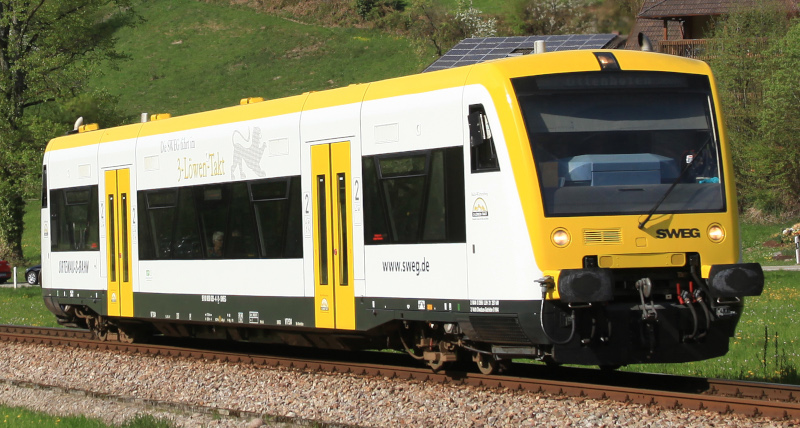
RegioShuttle RS1, series 1, commuter train services
In its basic design, the commuter model of the RegioShuttle RS1 has more space for standing passengers and more flip-up seats in multi-purpose areas. A toilet was not included in the basic model of the vehicle to allow for a higher number of passengers for commuter services. The double motorization of each vehicle, which enables acceleration of 1.2 m/s² on average in the speed range of 0 to 50 km/h, is proving to be an advantage for the use of the RegioShuttle RS1 in commuter transport with respect to optimizing schedules. The vehicles are equipped with central buffer couplings. The RS1 for commuter transport can run in multiple heading and can also be used for feeder trains. In addition to a passenger information system, forced air ventilation and an air-conditioning unit, vending machines for passengers can also be installed in the multi-purpose areas inside the compartment.
It is possible to retrofit an accessible universal toilet in this vehicle, for use in regional transport, for example. HEROS can carry out the retrofitting, including engineering, installation and clarification of any approval issues with the authorities.
Photos of railcar RegioShuttle RS1, series 1, commuter train services

Photo: © Martin Müller, www.BahnStatistik.de

Photo: © Martin Müller, www.BahnStatistik.de

Photo: © Martin Müller, www.BahnStatistik.de
Technical data of railcar RegioShuttle RS1, series 1, commuter train services
(for information only)
| track gauge | 1435 mm |
| maximum speed | 120 km/h |
| starting acceleration | 1.2 m/s² on average from 0 to 50 km/h |
| unladen weight | 41 t |
| gap filler | Retractable step (standard feature) |
| floor height at entrance above top of rail | 580 mm … 600 mm in the low-floor area |
| percentage of low-floor area | 65 % |
| number of doors | 2 on each side |
| type of doors | Slide-plug doors with electric drive |
| span of entrance doors | 1300 mm |
| number of 2nd class seats | 62 to 64, depending on model |
| number of tip-up seats | 8 in the multi-purpose areas |
| number of standees | Up to 83 passengers at 4 p/m², depending on model |
| air-conditioning | Driver cabs and passenger area |
| heating | Hot water with waste heat from the diesel engines and auxiliary heater |
| ventilation | Forced air ventilation |
| illumination | Fluorescent lamps and energy-saving lamps in the boarding area |
| toilets | none (commuter train layout) |
| driver's / engineeer's cab | 2 (bidirectional vehicle) |
| windows | Fixed, double-glazed windows |
| producer of vehicle | ADtranz |
| train control | MICAS |
| multiple traction / feeder train | 5-unit or 3-unit |
| car body | Steel |
| axle arrangement | B'B' |
| bogie wheel base | 1,800 mm |
| total wheel base | 18,900 mm |
| axle load | 14 t |
| secondary suspension | Air suspension / air ride |
| length over buffers | 25,500 mm |
| lenght of car body | 24,460 mm |
| distance between bogie centres | 17,100 mm |
| width of car body | 2,900 mm |
| height of car body above top of rail | 3700 mm (railcar body) |
| smallest curve radius | 140 m (coupled) |
| smallest curve radius | 100 m (uncoupled) |
| buffers, draw hook, screw coupling | Yes |
| type of brake | KBGM-P (KC - P - H - D - A - Mg - el) |
| braked weight / mass | P: 60 t; P+Mg: 81 t |
| diesel engine | 2x MAN D 2866 LUH 21 (EURO II) |
| engine output | 2x 257 kW at 2000 U/min |
| fuel tank | 2x 400 l |
| power transmission | Diesel-mechanic with retarder |
| workshop supply | AC 230 V 50 Hz |
| manual transmission | Voith DIWA D864 (four-speed transmission) |
